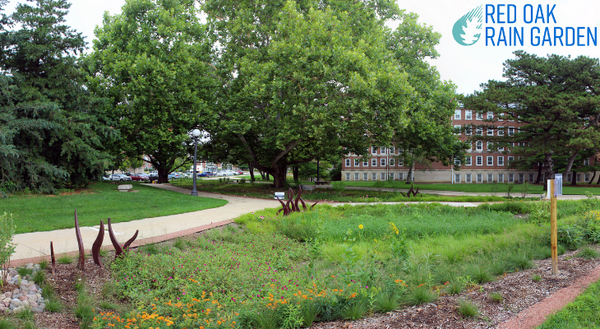
A homeowner who is interested in eco-friendly gardening may want to consider incorporating a rain garden into their landscape.
A rain garden is a permeable landscape feature that improves the quality of water runoff while adding beauty and supporting pollinating insects and birds. Typically located near a home’s downspout, but at least 10 feet away from the foundation, they take the form of shallow basins filled with native plants, filtering water and allowing stormwater runoff to soak into the ground.
Eliana Brown is a Stormwater Specialist with the Illinois-Indiana Sea Grant and Illinois Extension. Elliana and her team designed and built the Red Oak Rain Garden on the campus of University of Illinois to demonstrate the principles of rain gardens and inspire people to want to learn more about them. Located between Allen Hall and McKinley Health Center, the site of the Red Oak Rain Garden had limited sidewalk use after storms and the standing water was impairing the red oak on the site.
Eliana says “As the first rain garden on campus, this garden is both beautiful and smart. It addresses flooding in an innovative way—by planting an attractive landscape feature that captures and cleans up stormwater.” The garden plants, which are mostly native to Illinois, have extensive root systems that are excellent at soaking up water.
Some of these plants recommended to soak up rainwater are common names to gardeners. Layne Knoche, Visiting Extension Outreach Associate and Red Oak's landscape designer suggests woody plants like Arrowwood viburnum (Viburnum dentatum), red buckeye (Aesculus pavia), paperbark maple (Acer griseum) and sweet bay magnolia (Magnolia virginiana) for areas that do not drain well. Layne has categorized plants into three categories and suggests planting them in groups or ‘drifts’ of five or more
Bank plants (Placed higher up in the landscape and take drier conditions)
- Purple poppy mallow (Callirhoe involucrata)
- Prairie dropseed (Sporobolus heterolepis)
- Royal catchfly (Silene regia)
- Butterfly weed (Asclepias tuberosa)
Slope plants (Mid-level plants)
- Blazing star (Liatris spicata)
- Great blue lobelia (Lobelia siphilitica)
- Purple coneflower (Echinacea purpurea)
- Prairie alum root (Heuchera richardsonii)
- Orange Coneflower (Rudbeckia fulgida)
Basin plants (plants in the basin can handle wet feet and standing water of more than 18 hours)
- Common Rush (Juncus effusus)
- Northern blue flag iris (Iris versicolor)
- Swamp milkweed (Asclepias incarnata)
- Joe pye weed (Eutrochium purpureum)
- Cardinal flower (Lobelia cardinalis)
Knoche also includes ground covers like Pennsylvania sedge (Carex pensylvanica) and Jacobs’s ladder (Polemonium reptans) to plant under trees.
The team recently added new drifts of various native species, including Nodding Onion (Allium cernuum), Woodland Phlox (Phlox divaricate), and Virginia Bluebells (Mertensia virginica).
For more information on building and designing a rain garden in your landscape, visit redoakraingarden.org, and follow Red Oak Rain Garden on Facebook, Twitter, and Instagram at @RainGardenUIUC.